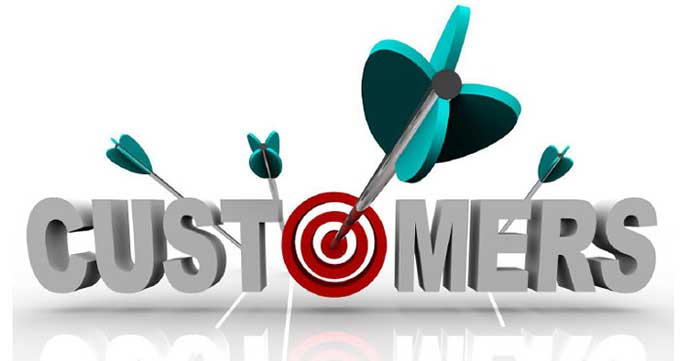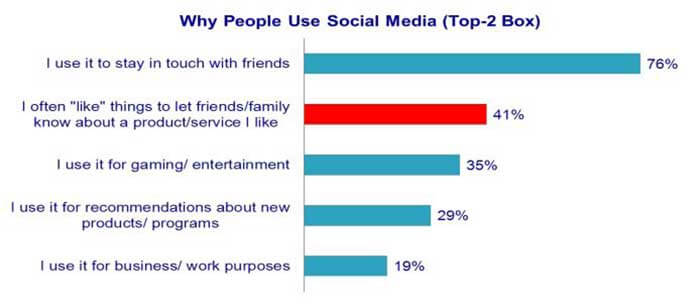This article has tons of valuable knowledge on how to use social media for lead generation and succeed in launching social media marketing campaigns.
Admit it – you’ve been doing it wrong. I mean the social media marketing. I know a lot of people have. Time after time they try to generate sales using Facebook, Twitter, Instagram, Pinterest, LinkedIn etc., and eventually fail. All they need though is to realize one little thing about social networks – one little thing that could make huge difference. And of course, here in this article I would like to share this precious knowledge with you, for free.
Before we get to that, let’s revise what we all know about social networks to see if we’re on the same page here.
Social Networks Today
Here’s a bunch of facts for you to think about:
- 2/3 of the world population use social media regularly (if you take US only, the percentage is almost the same – 67%);
- all age groups are represented, although the highest usage is among 18-29 year olds.
What does it mean? It means that social networks are overwhelmingly and universally popular within all age groups out there. In short, everyone is on social networks, including your customers.
Let’s take a quick look at high-level stats of 5 major social networks (as of April 2016, according to Statista):
1. Facebook – 1.59 billion active users
Since its inception in 2004, Facebook has been the leading social network in the world, having replaced My Space somewhere along the way as the new, cutting-edge way of communication.
Nowadays, however, Facebook is viewed by many young people as something their parents would use and somewhat “unhip.” Due to this trend, Facebook has started losing its core age group members (18-29) to Instagram and Snapchat. As a result, 30-49 and 50-64 age groups are expected to grow in the coming years on Facebook.
Another surprising fact about Facebook is that 84.5% of its daily active users are outside the US and Canada, which, again, proves that it’s a truly global thing.
2. Instagram – 400 million active users
Extremely popular with the younger audiences, Instagram is currently the fastest growing social network. Every day people share no less than 70 million photos on Instagram – come to think of it.
Another cool fact that says a lot about this social network is that Top-3 most-followed Instagram accounts are Selena Gomez, Taylor Swift, and Ariana Grande.
If your audience is teenagers, Instagram is the place to find them.
3. Twitter – 320 million active users
Much like Facebook, Twitter is starting to lose its initial “hip” appeal, as a lot of teens prefer it to Snapchat for instant photo-, video- and thought-sharing.
4. Pinterest – 100 million active users
Pinterest is quite unusual compared to other social networks mainly because 85% of its users are female. On Facebook, Twitter or Instagram male and female audiences are split quite evenly.
Just like the others, Pinterest has its own way of monetizing (sic advertising) called Sponsored Pins. And with the recent (June 2015) addition of Rich Pins, or “buyable pins,” which allows people to purchase stuff directly from Pinterest simply by tapping the button on a pin, it opened even more opportunities for small businesses.
5. LinkedIn – 100 million active users
LinkedIn is also somewhat different from the rest of the batch, as it’s a professional network designed for specific purposes of finding jobs and making new business contacts.
Interestingly enough, roughly 25% of LinkedIn users come from the US (compare with Facebook and see the difference).
These are the 5 major social networking platforms. I forgot to mention YouTube, Reddit, Badoo, and other social media outlets – although not really social networks, they’re still quite similar in terms of approach.
While using all these social media sources for lead generation, keep in mind that nothing is set in stone and it’s highly possible that new networks may emerge or the current ones will radically change or fade away (remember My Space and shed a tear).
“OK,” you might say, but…
“What’s so Special About Social Networks and Why Should I Care?”
Believe it or not, there are reasons for such domination of social networks. Understanding these reasons will help you open your mind to the possibilities provided by the social media.

So, why social networks are so popular with regular people and businesses?
Reason 1. Social Networks are Cheaper for Advertisers
Nothing personal here, just business. The cost of PPC (Pay per click) advertising on Facebook is around $0.8 per click, while with Google AdWords you’ll have to cough up $2.5.
Reason 2. Social Networks are Far-Reaching
Due to their enormous popularity, social networks are everywhere and everyone’s on them. It’s the easiest, most widely-accessible communication tool out there.
A lot of people = a lot of potential customers, and where there are a lot of potential customers, there bound to be a lot of potential sellers – and that includes you as well, doesn’t it?
Reason 3. Social Networks Allow Precise Targeting

Well, everything is targeted now to a certain degree, you might object. Yes, it’s true, but social networks offer a very deep and precise targeting.
For example, Facebook targeting includes not only basic stuff like age, gender, location, and language, but also interests and behavior.
Reason 4. Results on Social Networks are Easily Measurable
Money likes to be counted, as they say. So do our results – no matter how much effort we put into some promotion, we want to know exactly what results it yielded.
Social networks provide us with the tools to set up, launch and measure the results of campaigns and other promotional activities.
The more you learn, the more you earn.
Why do People Use Social Networks Anyway?

Source: therealtimereport.com
There are three main factors that drive social network users. They are:
- communication
- entertainment
- education
That’s right – communication, entertainment, education – in decreasing order. People initially create accounts to connect with other individuals or groups of people online.
When they’re not communicating with each other, they’re probably looking through their feed trying to find something worth attention, usually a hilarious picture, or a video.
Only a small percentage of social network users view Facebook or Twitter as a valuable source of information, whether it’s news or articles or blogs.
And now we’ve come to the grand mystery, the Holy Grail, the one and only original idea behind any social network. Once you understand and embrace it, your attitude towards generating sales via social networks will change forever. For the better, I might add.
The Main Idea Behind Any Social Network
Take a red marker and write this down on the wall of your office or home.
GROW AUDIENCE FIRST, MONETIZE IT SECOND
You’ve read it. Now repeat it slowly. A-U-D-I-E-N-C-E F-I-R-S-T, M-O-N-E-Y S-E-C-O-N-D. It may come as a shock at first, but it makes perfect sense once you’re into this thought.
If you take a quick look at the history of any social network, you will notice that they all share something in common. When they were just startups with limited amount of financing, all they cared about was users. How to satisfy the existing users and where to find the new ones.
Once this problem was gone and the project was riding high with a few million fans on board, the management switched to monetizing mode – only then they started thinking about the money.
What happens on the social networks can be called connecting the audience with the sales, not vice versa.
No wonder this is the most common mistake people make when they start using social media for leads. They desperately try to push their product to those three hundred poor people who liked/followed their social network page.
See, using social media for leads is like going on a diet – it’s bound to take some time and effort before you see the results. Don’t expect losing 20 pounds in 5 days simply by cutting down on fast-food and switching to Diet Coke. It requires much more than that.

Until you view it as a temporary thing, something that will come and go, you won’t get far. Instead, you should treat your social network account as something permanent that is here to stay. You should nurture it, develop it, and improve it step by step, adding more value to your subscribers/followers. Only after you’ve reached a certain milestone, you can start trying to monetize them.
So, if you’re ready to see how it’s done, let’s kick off these 11 steps to using social media for leads.
11 Steps to Using Social Media for Leads.
Just like we agreed before, I’ll start with the audience first, and then proceed to the sales.
Audience
The main thing you need to be aware of is that people like/follow your social media page not because they want to buy something from you, but because they think it may be of some value to them. And by value they usually don’t mean your “Hey, check out this new product!” posts.

So, in order to succeed, you should bring value to your users – with every post, picture, or video. Have it hardcoded onto your mind.
Step 1. Find Your Audience
Before making any actions, sit down and define your potential customers. Who are these people? Middle-aged car sales managers? Teenagers who play computer games? Moms with three kids?
The more precisely you describe your target audience, the better. There is a great article on my blog that will help you out – it’s called “How to Create a Buyer Persona for Your Business and Get More Clients.” You should definitely check it out.
Once you know who you’re after, make your choice of the social network. By now, you should know enough difference between Facebook and LinkedIn, Instagram and Pinterest to choose the one that’s right for your business. You can’t be equally present everywhere – you’re not Kim Kardashian, are you?
Finally, when you’ve chosen the main social network, start zeroing in on your audience by using built-in targeting tools – age, location, gender, interests, behavior etc.
Step 2. Build Your Audience
This is where it all really starts. Provided you know your audience well enough, you should be able to come up with some interesting content ideas. Something that will bring value to these people, remember? Something that will not make them want to unsubscribe instantly. If you want a shortcut to great content strategy, it’s right here in this article “What is Content Marketing: Guide to Successful Content Strategy.”
For example, if your business is teaching Spanish online, be sure to create some interesting articles on how to learn Spanish first, make video tutorials, spreadsheets, post famous Spanish quotes etc.
Once you feel that your audience starts to pick up on this idea and you get more likes, shares, and new subscribers daily, begin introducing the so-called “promotional” posts.
Be careful though – most experts agree on an 80/20 principle, meaning that 80% of your content should be “valuable for users,” and the rest is promo. If you’re just starting the whole thing up, you can go as high as 95/5, gradually increasing the amount of promotional posts as you grow and build your audience.
Step 3. Become an Expert for Your Audience
It requires a lot of knowledge and expertise to earn trust. How can people trust you teaching them Spanish if you can barely speak it yourself, amigo?
Be an expert in your field and share your expertise generously with your fans.
Step 4. Entertain and Educate Your Audience

You do realize, that social networks are all about communication, entertainment and learning stuff, don’t you? That’s why you need to entertain your audience by sharing lots of multimedia content, such as pictures and videos. Don’t forget about reposts of other successful posts too.
Stay in touch with current events and do comment on them, while keeping it relevant to your main topic.
Step 5. Communicate With Your Audience
SOCIAL networks, remember? And that includes you – you’re just as member of a social network as these people, who are your fans. So treat them like ones!
Every time you get a comment, question, or any other incoming message, be quick to reply to it in a polite, professional, and (optional) humorous manner. If you ignore people, they will ignore you too. It’s as simple as that.
Not every comment deserves a reply though. There are some people (very few, really) who are on a mission to make other people’s lives miserable, just like their own. You can call them trolls, haters or whatever. If you spotted a message from such person (usually containing a lot of profanity and no valid argumentation other than you’re a bad guy), simply ignore the jerk. They’ll go away soon.
More information on conflict resolution and dealing with angry customers is available in this monster of an article “6 Successful Tactics of Dealing with Negative Online Reviews.”
Step 6. Grow Your Audience
Of course, growing may also happen organically, simply by word-of-mouth – if you produce content that is highly original and valuable by itself.
Still, you can be proactive about it and stimulate this process. Encourage people to share your content, like your page, comment and display general activity. There’s nothing wrong in asking for an opinion about something that you’ve done, or helping spread the good word about it.
Be proud of your content, and your fans will be proud to share it.
Sales
Yes! We’re finally there! Now that your social network page is up and running, it’s time to take some advantage of your success and try to capitalize on it. Welcome to the Dark Side of social media, my young padawan 🙂

Step 7. Direct Leads to Your Website to Get Sales
Don’t try to sell stuff directly on Facebook or Instagram – it rarely works. Instead, view your fans on social network as one of the channels to fill your sales funnel.
Therefore, you need to show them the way to a better life by redirecting them to a landing page you’ve created for your product/service. Why? Because social networks can only give a limited amount of information about your product or service, while a landing page offers more conversion opportunities.
This tactic is often called “gated content.” For example, you create a post offering 10 free hours of Spanish lessons and supply a link to your landing page along with it. Once a user clicked on that link, he would be redirected to your landing page where he most probably would be asked to provide some personal information to get access to that “gated” content (email address).
User gets the content and you get a sales lead – how cool is that? Gated content helps sort the real buyers (people who have genuine interest in what you have to offer) from casual users who are not willing to commit yet.
Step 8. Generate Sales with Contests and Giveaways
“FREE” is a magic word. People like free stuff. Always have, always will. Besides, there’s nothing wrong with attracting some interest to your product and creating a little buzz around it.
As with many marketing tools, it’s all about cold heart and calculations. For example, your free 10-hour Spanish course would normally cost $99.99. So, if you’re about to give it away, make sure you get your money’s worth. If your conversion rate is 0.5%, then you need to attract at least 200 people. Makes sense?
Also, try to use your own products/services as an incentive while doing these contests. After all, it’s about your promoting business, not about giving away a smartphone to a random guy.
Step 9. Use Social Media Advertising to Drive Even More Sales
It’s so obvious that it’s even not worth mentioning. All social networks have built-in advertising tools, which are highly customizable, depending on your requirements. You create an ad, define its targeting parameters, and pay money per each click.
Sounds simple enough, but be sure to explore all available options before launching your campaign.
Step 10. Host Hangouts or Webinars to Connect With Your Sales Prospects
This might not seem like a universal advice, but it is though. As you may have learned from today’s article, some people view social networks as a source of valuable information, new knowledge.
For these people, such experience with you and your social media account would be invaluable! You may only have 20 or 30 people on your webinar, but these people would show higher conversion than any other type of customer.
Plus, you establish an almost personal connection and help spread the word about your business, which is great by itself.
Step 11. Measure Your Success to Generate Future Sales
All social networks have built-in analytics tools, which are very helpful. It’s not even a question, whether you should use them to track:
- how many new fans you get and where they come from
- the performance of your posts (likes, shares, comments etc.)
- how much money you’ve made (or spent) on campaigns
Based on this data, you should tweak your overall strategy and drive your social media account to even more sales.
The right thing to do would be share this article with your friends on the social networks – just click on one of the icons of social media, it’s that easy.
If you have further questions on the subject, please write them in comments – I’ll be glad to answer.





Hi Viktor,
Thanks for sharing information about how to use Social Media for lead generation. Your article was a best guide to target Social Media to get good number of visitor to any product or services. My self I am in Social Media from last five years. Most of the time spent on Social Media is same as mentioned in topic. Your topic is very useful to new webmaster to promote website regularly to get decent traffic and increase own profit.
Glad you liked the post Jamir. Social media is the greatest tool for lead generation, to get decent traffic and increase profit. Keep in touch with me and you find a lot useful information about any type of digital marketing in the future articles.